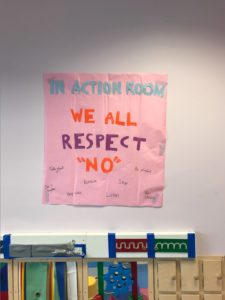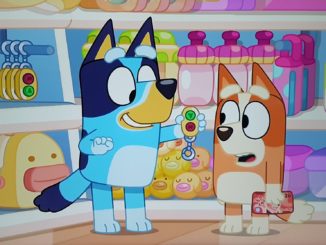I shared this image, with the following caption, for the first time two years ago:

Getting my therapy gym room ready for the new school year!
I put up this sign this year… “In Action Room, we ALL respect ‘No’.”
Grown-ups and kids. If a grown-up tells a child “No, we can’t do that,” then we can’t do that. But if a child tells a grown-up, “No!”, then I want the grown-up to respect them right back.
Kids with disabilities or special needs are already at even higher risk for abuse. I strongly believe that a big component of that is the fact that they’ve spent years of their lives with adults ignoring their “no” and making their body do things that it doesn’t want to do…so why would they think it’s any different, or that they should tell someone or get help, when it crosses a line into actual abuse? If it just feels like more of the same?
In my gym, we will try to understand what their concerns are, we will listen to what they have to say, we might offer a choice or a suggestion, we might get playful, we might offer to do it with them…but if they still say no, then we respect that no.
***
Reflecting on it two years later, I can see how pivotal of a point this was in my journey toward embracing truly, fully child-led play in my therapy sessions. It was never the kind of thing where I woke up one day and canceled adult-led therapy and switched to child-led play-based therapy all in one go; it was an ongoing process that’s taken the whole of my career thus far. I was playing before I put up this sign, and I was still changing and growing after I put up this sign, and I’m still changing and growing now! But, I can see what a crucial turning point this was for me.
I came to a brand-new job 8 months before I put up this sign, in the middle of the American school year. Two of my predecessor OTs had moved on before I got there to fill the open position, so I was only learning about what they did in the past tense, like people telling me, “The last OT used to…” I knew that the type of therapy that they had been doing didn’t feel like something that I could really step in and fill the same shoes. I had different priorities and I wanted to write different goals for the kids and I had different ideas of the best way to help them and connect with them.
There are lots of types of therapy in the world. I’m pretty “out there” as practitioners go. 😉 I definitely don’t think that all OTs need to be exactly like me or else they’re doing it “wrong”, or anything like that. But, I also knew that me copying exactly what someone else had done simply didn’t feel authentic or right to me.
It was leading to situations where I felt stuck, or at a dead end. I had a significant experience with a little kindergartener and I simply sitting at an impasse for an entire OT session because he “wouldn’t” do the worksheet that I had brought for him to do, and honestly, I didn’t even WANT to be trying to make him do a worksheet, so in the moment I froze up! I sat quietly next to him on the floor of a classroom while he sat in a desk and very slowly and quietly broke all of my crayons. I didn’t know what to do. I didn’t know how to fix it in the moment. Inside my mind I was yelling at myself, “He can’t do this, he obviously can’t do this, and I don’t even want to be trying to make him do this, why am I doing this?”
It was also leading to situations where I felt like I wanted to take children’s “side”—or rather, be on their team!—but instead I felt paralysed and like I had to be on the adults’ “side”. There was another person in the school who would use the therapy gym in a set routine. First you do climbing, then you do swinging, then you do trampoline, or whatever it was. Sometimes kids wouldn’t want to do one of the things. Sometimes they would even be crying while they made them go on the swing and I was just thinking, why are we doing this? Surely there is no sensory benefit to being forced into experiences while you’re miserable. Something has to change.
There’s a lot of turnover in my job because it’s on a military base, so families are constantly being reassigned and moving to a new place every couple of years. After that one semester of feeling like I needed to fill the shoes of who had come before me, but simultaneously feeling like they weren’t right for me, I suddenly found myself as the only remaining person using the therapy gym and in charge of therapy in a lot of spheres. I didn’t have anybody looking over my shoulder. I could practice the way I wanted to. I didn’t even fully know what “the way I wanted to” was.
Years ago, in the states, I used to work some of the time at a group home for children in the foster care system who had intensive behavioral or medical needs and needed 24/7 care. I used to do entirely play-based therapy with them. I thought, at the time, that it was right for them because of the trauma and challenges they’d had throughout their life—most of them didn’t respond well to more of being told what to do, and honestly, I didn’t *like* just walking in and telling them what to do. So instead I just offered a bunch of cool stuff and followed their lead.
Now it occurred to me that most of the kids here had been through a lot of trauma, too. We were still hardcore in the middle of covid; nobody was sure if schools would stay in-person or fluctuate back to virtual, and everyone was still wearing masks, and all of the kids had had at least some years of having virtual schooling or gaps in their schooling. On top of that, the unique factors of being in a military family, having parents be deployed, having to move around every 2-3 years or have all your friends and adults/professionals also move around every 2-3 years is pretty significantly disrupting if not traumatising. That was the branch from which I started thinking, “Maybe I should try practicing OT here like I did at the group home back in the states.” And that was the start of walking down a path to realising that child-led, play-based OT was authentically occupationally meaningful for ALL kids, not just kids who came from traumatic backgrounds, because kids are supposed to play and kids are supposed to grow in autonomy and self-advocacy and explore and understand the world around them!
So a world of “yes” started with the capacity for “no”.
And I’m still on this journey today! And I’m so, so happy I have you all with me, wherever you’re at, whatever you’re taking from this page, whatever we’re all learning together. ❤



